Abstract
The proportion of irradiated sludge for the enhancement of the biological nitrogen and phosphorus removal from wastewater by low-intensity ultrasound was optimized through contrast experiment between two anaerobic–aerobic–anoxic–aerobic sequencing batch reactors ((AO)2SBR) with and without ultrasound. Ultrasound with the intensity of 0.2 W cm−2 was employed to irradiate a certain proportion of the condensed sludge in one of the (AO)2SBRs for 10 min every 12 h. Results showed that the optimal sludge proportion for ultrasonic promotion of chemical oxygen demand (COD), total phosphorus (TP), and total nitrogen (TN) removal was from 12.0% to 13.5%. In addition, the effluent COD, TP, and TN of the ultrasonic reactor could be decreased of 37%, 40%, and 5.8% on average compared with the control reactor (without ultrasonic irradiation) under the optimal condition. Furthermore, the settling ability of the sludge was affected but not deteriorated by ultrasonic irradiation.





Similar content being viewed by others
References
Abufayed, A. A., & Schroeder, E. D. (1986). Kinetics and stoichiometry of SBR/denitrification with primary sludge carbon source. Journal Water Pollution Control Federation, 58(5), 398–405.
APHA, AWWA, & WEF (1998). Standard methods for the examination of water and wastewater. Washington, DC: APHA, AWWA, WEF.
Bar, R. (1988). Ultrasound enhanced bioprocesses: cholesterol oxidation by Rhodococcus erythropolis. Biotechnology and Bioengineering, 32(5), 655–663.
Chu, C. P., Lee, D. J., Chang, B. V., You, C. S., & Tay, J. H. (2002). "Weak" ultrasonic pre-treatment on anaerobic digestion of flocculated activated biosolids. Water Research, 36(11), 2681–2688.
Czerska, B., Miksch, K., Matsche, N., & Franz, A. (1997). Application of enzymatic activity measurements to biological phosphate removal from wastewater. Water Science and Technology, 36(10), 87–95.
Dai, C. Y., Wang, B. C., Duan, C. R., & Sakanishi, A. (2003). Low ultrasonic stimulates fermentation of riboflavin producing strain Ecemothecium ashbyii. Colloids and Surfaces. B: Biointerfaces, 30(1–2), 37–41.
Lee, D. S., Jeon, C. O., & Park, J. M. (2001). Biological nitrogen removal with enhanced phosphate uptake in a sequencing batch reactor using single sludge system. Water Research, 35(16), 3968–3976.
Lin, L. D., & Wu, J. Y. (2002). Enhancement of shikonin production in single- and two-phase suspension cultures of Lithospermum erythrorhizon cells using low-energy ultrasound. Biotechnology and Bioengineering, 78(1), 81–88.
Liu, Y. Y., Takatsuki, H., Yoshikoshi, A., Wang, B. C., & Sakanishi, A. (2003). Effects of ultrasound on the growth and vacuolar H+-ATPase activity of aloe arborescens callus cells. Colloids and Surfaces. B: Biointerfaces, 32(2), 105–116.
Liu, H., He, Y. H., Quan, X. C., Yan, Y. X., Kong, X. H., & Li, A. J. (2005a). Enhancement of organic pollutant biodegradation by ultrasound irradiation in a biological activated carbon membrane reactor. Process Biochemistry, 40(9), 3002–3007.
Liu, H., Yan, Y. X., Wang, W. Y., & Yu, Y. Y. (2005b). Improvement of the activity of activated sludge by low intensity ultrasound. Environmental Sciences, 26(4), 124–128.
Lu, H. B., Qin, L., Lee, K., Cheung, W., Chan, K. M., & Leung, K. (2009). Identification of genes responsive to low-intensity pulsed ultrasound stimulations. Biochemical and Biophysical Research Communications, 378(3), 569–573.
Pitt, W. G., & Ross, S. A. (2003). Ultrasound increases the rate of bacterial cell growth. Biotechnology Progress, 19(3), 1038–1044.
Rokhina, E. V., Lens, P., & Virkutyte, J. (2009). Low-frequency ultrasound in biotechnology: state of the art. Trends in Biotechnology, 27(5), 298–306.
Schlafer, O., Sievers, M., Klotzbucher, H., & Onyeche, T. I. (2000). Improvement of biological activity by low energy ultrasound assisted bioreactors. Ultrasonics, 38(1–8), 711–716.
Schlafer, O., Onyeche, T., Bormann, H., Schroder, C., & Sievers, M. (2002). Ultrasound stimulation of micro-organisms for enhanced biodegradation. Ultrasonics, 40(1–8), 25–29.
Xie, B. Z., & Liu, H. (2009). Enhancement of biological nitrogen removal from wastewater by low intensity ultrasound. Water, Air, and Soil Pollution. doi:10.1007/s11270-009-0289-0.
Xie, B. Z., Wang, L., & Liu, H. (2008). Using low intensity ultrasound to improve the efficiency of biological phosphorus removal. Ultrasonics Sonochemistry, 15(5), 775–781.
Xie, B. Z., Liu, H., & Yan, Y. X. (2009). Improvement of the activity of anaerobic sludge by low-intensity ultrasound. Journal of Environmental Management, 90(1), 260–264.
Yan, Y. X., & Liu, H. (2006a). Mechanism of low intensity ultrasound enhanced biological treatment of wastewater. Environmental Sciences, 27(4), 647–650.
Yan, Y. X., & Liu, H. (2006b). Optimization of irradiation cycle for enhancement of biological treatment of wastewater by low intensity ultrasound. Environmental Sciences, 27(5), 898–902.
Yan, Y. X., & Liu, H. (2006c). Optimization of the proportion of irradiated sludge for enhancement of sludge activity in biological treatment of wastewater by low intensity ultrasound. Environmental Sciences, 27(5), 903–908.
Yan, Y. X., Liu, H., Zhang, S. L., & Xie, B. Z. (2006). Treatment of domestic wastewater using sequence batch reactor enhanced by low intensity ultrasound. Environmental Sciences, 27(8), 1596–1602.
Acknowledgements
The research was supported by the Major Projects on Control and Rectification of Water Body Pollution by the Ministry of Science and Technology of PRC (No.2009ZX07317-006-03) and the Innovation Foundation of BUAA for PhD Graduates. The authors also appreciate the Key Laboratory for Biomechanics and Mechanobiology of Ministry of Education.
Author information
Authors and Affiliations
Corresponding author
Rights and permissions
About this article
Cite this article
Xie, B., Liu, H. Optimization of the Proportion of the Activated Sludge Irradiated with Low-Intensity Ultrasound for Improving the Quality of Wastewater Treatment. Water Air Soil Pollut 215, 621–629 (2011). https://doi.org/10.1007/s11270-010-0504-z
Received:
Accepted:
Published:
Issue Date:
DOI: https://doi.org/10.1007/s11270-010-0504-z




